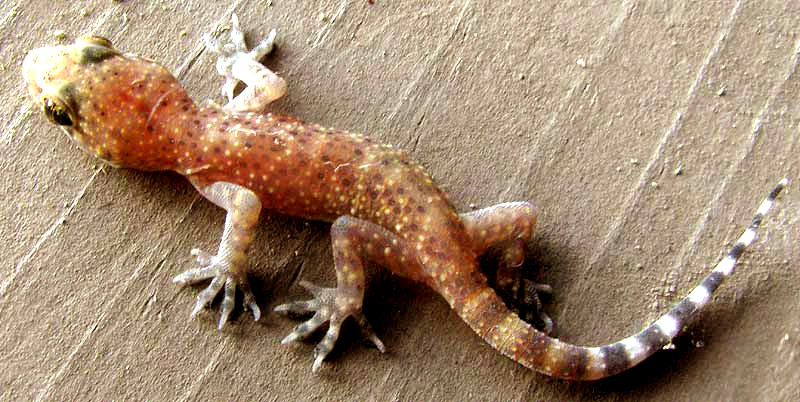Excerpts from Jim Conrad's
Naturalist Newsletter

from the September 23, 2012 Newsletter issued from the valley of the Dry Frio River in northern Uvalde County, southwestern Texas, on the southern border of the Edwards Plateau; elevation ~1750m (~5750 ft); N29.62°, W99.86°; USA
MEDITERRANEAN HOUSE GECKO
I was painting one of the cabin's rooms and noticed that a baseboard had come loose from the wall, so I began pounding a nail into it. This resulted in a three-inch-long (8cm) gecko shooting onto the floor, who just sat there looking dazed, and I guess he had a right to be. You can see him, looking pretty good despite what must have been the mother of all headaches, if geckos have headaches, above.
With the big eyes and semi-translucent, reddish body he might be mistaken for a salamander or newt, though I've never heard of one of those living behind a baseboard in a cabin. One indication that the little fellow isn't one of those is that he is covered with scales -- in the picture not very apparent except on the front legs. Salamanders and newts are amphibians, so they don't have scales. Geckos are reptiles, and reptiles do have scales.
This is the Mediterranean House Gecko, sometimes also called Turkish Gecko or Common House Gecko, despite the latter name being applied to another species as well. It's HEMIDACTYLUS TURCICUS, which my Audubon field guide describes as the most conspicuous gecko in North America, despite its being native to the Mediterranean region, Middle East and India. Now the species is spread spottily throughout the world's tropical and subtropical zones.
In the US Mediterranean Geckos were first reported in Key West, Florida in 1915, but now they're found here and there throughout the southern states, coast to coast. Mostly they occur around major urban areas, so ours way off the beaten path in southwestern Texas is a little unusual. So far it seems that the species can't compete with our native lizards in more natural habitats, and is pretty much dependent, like house mice, on the presence of human buildings and general human messes to survive.
Mediterranean House Geckos are entirely nocturnal, reaching their peak of activity around 2 AM. Sometimes you see them beneath lights left on all night, where insects trying to navigate by the stars crash and become gecko food.
We do have a native gecko species here, the Texas Banded Gecko, usually noticed crossing highways at night, and I'll be looking for that one, though instead of behind baseboards that species prefers deserty rock outcrops and canyon beds.